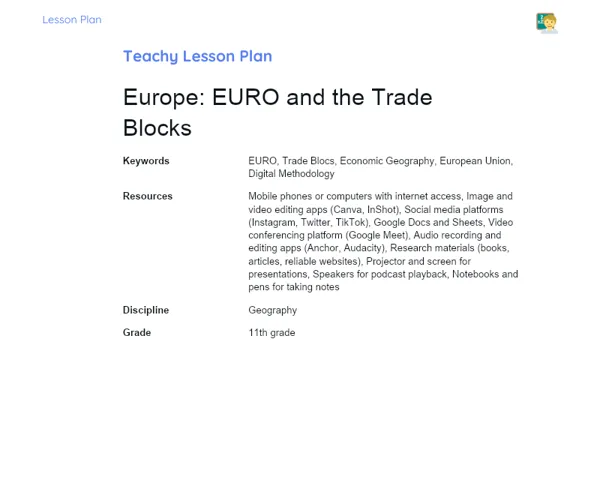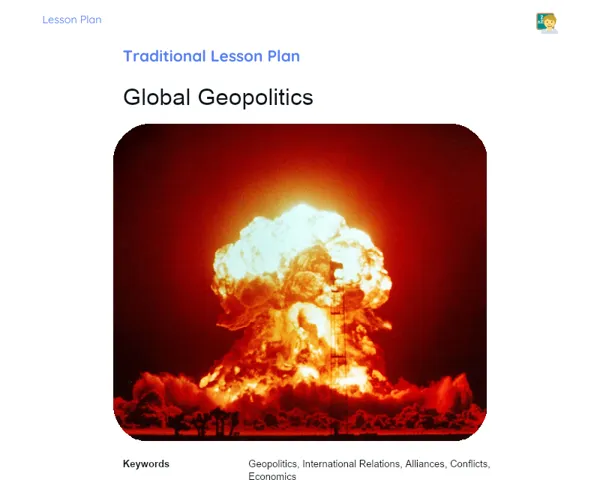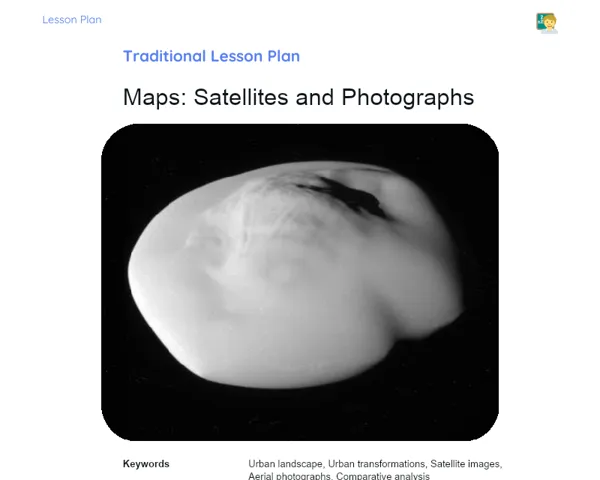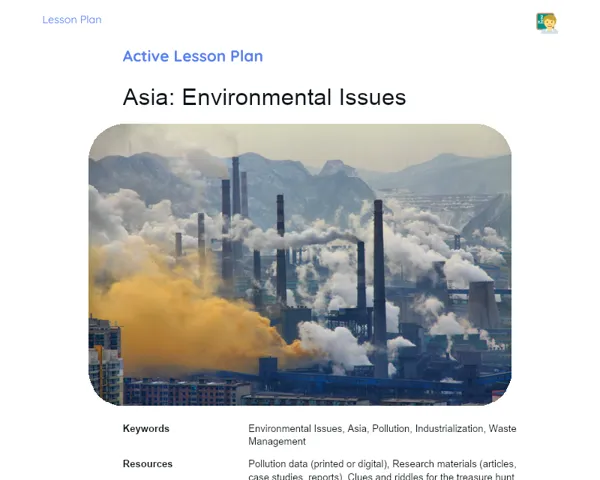Lesson Plan | Active Methodology | Work: Rural and Urban
| Keywords | Work in rural areas, Work in urban areas, Comparison of work environments, Local economy, Urban and rural resources, Practical activities, Illustrative maps, Work dynamics, Social and economic impact, Daily challenges |
| Necessary Materials | Descriptions of worker cases in rural and urban settings, Cards depicting urban and rural resources, Paper, Colored pencils, Ruler |
Premises: This Active Lesson Plan assumes: a 100-minute class duration, prior student study both with the Book and the beginning of Project development, and that only one activity (among the three suggested) will be chosen to be carried out during the class, as each activity is designed to take up a large part of the available time.
Objective
Duration: (5 - 10 minutes)
This objectives stage is pivotal in steering the focus of both students and the teacher during the lesson. By clearly outlining what should be accomplished, students can better organize their thoughts and get ready for hands-on activities. This section also ensures that everyone involved shares a mutual understanding of the purpose behind comparing rural and urban settings, which is vital for grasping how society and the economy function.
Objective Utama:
1. Enable students to identify and compare the characteristics of workspaces in rural and urban settings.
2. Cultivate the skill to recognize the similarities and distinctions in work models across urban and rural areas.
Objective Tambahan:
- Spark students' curiosity and interest in how work operates in diverse environments.
Introduction
Duration: (15 - 20 minutes)
The introduction aims to engage students and link their prior knowledge with real-world circumstances. The suggested problem scenarios encourage critical thinking about the nuances of work across different settings, setting them up for a comparative analysis. The contextualization also helps underline why it’s important to study work in rural versus urban contexts, showcasing how these environments directly impact local life and advancement.
Problem-Based Situation
1. Imagine you are a farmer in a small village. What daily challenges would you face compared to someone employed at a big corporation in a city?
2. Think about an office worker in a bustling urban centre. How would their daily life change if they suddenly found themselves working on a farm?
Contextualization
To grasp the differences between work in rural and urban environments, let's picture two scenarios: one with a farmer dealing with the unpredictable climate and soil conditions, and another with a tech professional in a city office grappling with heavy traffic and tight deadlines. These disparities not only shape the daily lives of workers but also affect the economy and development of their respective areas.
Development
Duration: (70 - 80 minutes)
The Development phase is set up for students to apply and deepen the knowledge they have gained about work in rural and urban contexts. Through engaging and interactive activities, students will practically explore the contrasts and commonalities between these work environments, cultivating critical thinking, collaboration, and detailed analysis. This approach reinforces learning while also enhancing communication and teamwork skills.
Activity Suggestions
It is recommended that only one of the suggested activities be carried out
Activity 1 - Work Detectives
> Duration: (60 - 70 minutes)
- Objective: Analyze the characteristics of work in rural and urban settings, building observational and analytical skills.
- Description: In this activity, students will be split into groups of up to 5, each receiving a 'case' to solve. The 'cases' include descriptions of real workers from rural and urban backgrounds, outlining their daily routines and challenges. Students will use this data to identify the type of work (rural or urban) and discuss the noted differences and similarities.
- Instructions:
-
Divide the class into groups of up to 5 students.
-
Hand out a 'case' to each group, featuring descriptions of a worker in rural or urban settings.
-
Give each group 15 minutes to discuss and analyze the 'case'.
-
Groups then present their findings in a classroom discussion, highlighting the characteristics of the identified work and the differences noted with the other context.
Activity 2 - Economy Builders
> Duration: (60 - 70 minutes)
- Objective: Comprehend the interdependence of resources within the local and regional economy, fostering critical thinking and collaboration.
- Description: Students, organized in groups, will receive cards illustrating various resources available in urban and rural areas. They will utilize these resources to 'construct' a sustainable economic model for both a small town and a farm, keeping the needs of their inhabitants and workers in mind.
- Instructions:
-
Group the students and provide each group with cards representing resources like land, water, energy, technology, etc.
-
Instruct each group to develop an economic model for a small town and a farm based on the resources provided.
-
Groups have 30 minutes to plan and create their models.
-
Each group presents their model, explaining how they used the resources to address the needs of the location and facilitate work.
Activity 3 - Work Maps
> Duration: (60 - 70 minutes)
- Objective: Visualize and spatially compare the characteristics of work in rural and urban settings, enhancing geographical comprehension and analysis.
- Description: In this activity, students will design maps that depict the differences between work in rural and urban settings. They should utilize symbols and colors to represent various work types, infrastructure, and specific challenges present in each environment.
- Instructions:
-
Divide the class into groups and provide materials such as paper, colored pencils, and rulers.
-
Explain that each group needs to draw two maps: one for a small town and another for a farm, emphasizing the types of work done and the challenges encountered in each area.
-
Students have 45 minutes to finalize their maps.
-
Each group presents their creations, articulating the chosen elements and their significance to the functioning of the area depicted.
Feedback
Duration: (10 - 15 minutes)
The aim of this stage is to consolidate learning, allowing students to express and share the knowledge they've gained. Group discussions foster communication and argumentation skills, while also giving students a chance to reflect on the information gathered and their peers' reasoning. This moment also allows the teacher to gauge students' comprehension of the subject matter and identify areas that may need further reinforcement in future lessons.
Group Discussion
Kick off the group discussion with a brief introduction stressing the importance of sharing the discoveries and learnings from the activities. Suggest that each group summarizes their discussion and conclusions. Encourage students to voice their thoughts on the variations between work environments and how these differences influence people's lives and the local economy. Pose targeted questions to ensure all significant aspects are addressed.
Key Questions
1. What key differences did your group note between work in rural and urban settings?
2. How do the characteristics of the work environment impact the lives and decisions of workers?
3. Did anything surprise you or spark your interest during the activity?
Conclusion
Duration: (5 - 10 minutes)
The Conclusion phase aims to solidify learning, ensuring that students grasped and absorbed the key takeaways from the lesson. Recapping the content helps bolster memory and ensure significant concepts are properly internalized. Moreover, by emphasizing the real-world relevance of these studies, students are motivated to recognize the importance of what they have learned in practical contexts.
Summary
In the conclusion, the teacher should summarize the main points discussed regarding the characteristics of work in rural and urban environments, highlighting the recognized differences and specificities of each workspace. It's crucial to touch upon the resources used, daily routines, and challenges faced by workers in each setting.
Theory Connection
Throughout the lesson, students were able to apply the theories studied at home through practical activities that allowed for direct comparisons between work in rural and urban settings. By working through realistic scenarios and illustrative maps, they could visualize and analyze work dynamics and their social and economic impacts, effectively linking theory with practice.
Closing
This exploration is vital as it sheds light on how various forms of work shape not just the economy, but also the everyday lives and well-being of individuals in both urban and rural landscapes. Acknowledging and appreciating these distinctions is paramount for shaping public policies and planning sustainable economic activities in both areas.



